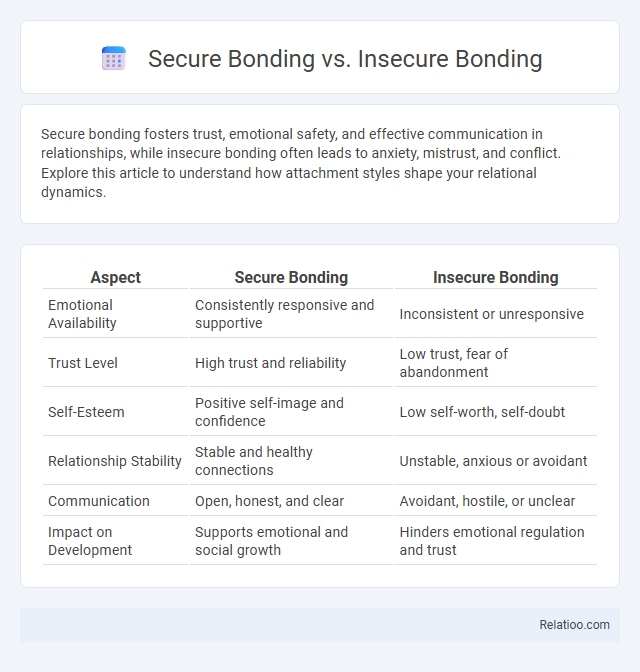Secure bonding fosters trust, emotional safety, and effective communication in relationships, while insecure bonding often leads to anxiety, mistrust, and conflict. Explore this article to understand how attachment styles shape your relational dynamics.
Table of Comparison
| Aspect | Secure Bonding | Insecure Bonding |
|---|---|---|
| Emotional Availability | Consistently responsive and supportive | Inconsistent or unresponsive |
| Trust Level | High trust and reliability | Low trust, fear of abandonment |
| Self-Esteem | Positive self-image and confidence | Low self-worth, self-doubt |
| Relationship Stability | Stable and healthy connections | Unstable, anxious or avoidant |
| Communication | Open, honest, and clear | Avoidant, hostile, or unclear |
| Impact on Development | Supports emotional and social growth | Hinders emotional regulation and trust |
Introduction to Bonding: Secure vs Insecure
Bonding forms the essential emotional connection between you and your caregiver, influencing your social and emotional development throughout life. Secure bonding fosters trust, safety, and healthy relationships, while insecure bonding can lead to anxiety, attachment issues, and challenges in emotional regulation. Understanding the dynamics of secure versus insecure bonding is crucial for promoting psychological well-being and resilience.
Definition of Secure Bonding
Secure bonding refers to a healthy emotional attachment where infants feel confident that their caregiver will meet their needs consistently and provide a safe environment. In contrast, insecure bonding arises from unpredictable or neglectful caregiving, leading to anxiety or avoidance in relationships. Bonding overall encompasses the emotional connection that forms between a caregiver and a child, influencing social and emotional development.
Characteristics of Insecure Bonding
Insecure bonding is characterized by inconsistent responsiveness, attachment anxiety, and fear of abandonment, often leading to emotional withdrawal or clinginess in relationships. Unlike secure bonding, which promotes trust and stability, insecure bonding results in difficulty regulating emotions and establishing healthy interpersonal connections. These patterns can stem from neglect, trauma, or unpredictability during early developmental stages.
Key Differences Between Secure and Insecure Bonding
Secure bonding forms a stable, trusting relationship where Your emotional needs are consistently met, fostering confidence and resilience. Insecure bonding, by contrast, results from unpredictable or neglectful caregiving, leading to anxiety, avoidance, or ambivalence in attachments. The key difference lies in the reliability and responsiveness of the caregiver, which directly impacts Your ability to form healthy, supportive connections throughout life.
Psychological Effects of Secure Bonding
Secure bonding fosters emotional stability and resilience by promoting trust and effective communication between individuals, particularly between caregivers and children. Insecure bonding, characterized by anxiety or avoidance, can lead to difficulties in emotional regulation and relationship-building later in life. The psychological effects of secure bonding include enhanced self-esteem, reduced risk of mental health disorders, and a foundation for healthy social connections throughout development.
Consequences of Insecure Bonding
Insecure bonding during early childhood can lead to difficulties in emotional regulation, trust issues, and impaired social relationships throughout life. Unlike secure bonding, which fosters confidence and healthy attachment, insecure bonding often results in anxiety, low self-esteem, and challenges in forming close connections. Your emotional well-being and ability to build meaningful relationships may be significantly impacted if insecure bonding patterns are not addressed.
Factors Influencing Bonding Styles
Factors influencing secure bonding include consistent caregiver availability, emotional responsiveness, and positive early interactions promoting trust and safety. Insecure bonding often arises from neglect, inconsistent caregiving, or caregiver rejection, leading to anxiety or avoidance in relationships. Genetic predispositions, environmental stressors, and attachment experiences collectively shape bonding styles in infancy and later life.
Impact on Relationships and Attachment
Secure bonding fosters trust, emotional safety, and effective communication, leading to healthy, resilient relationships and secure attachment styles. Insecure bonding, characterized by inconsistency or neglect, often results in anxiety, avoidance, or ambivalence, hindering emotional intimacy and causing difficulties in forming stable relationships. General bonding shapes the foundation of attachment, with secure patterns promoting positive interpersonal connections and insecure patterns increasing vulnerability to relational conflicts and emotional distress.
Improving Bonding: Strengthening Secure Attachment
Improving bonding centers on fostering secure attachment by promoting consistent responsiveness, emotional availability, and trust between you and your child. Secure bonding enhances emotional regulation, social competence, and resilience, whereas insecure bonding often leads to anxiety, withdrawal, or ambivalence in relationships. Strengthening secure attachment involves mindful communication, empathy, and supportive interactions that nurture your child's sense of safety and connection.
Conclusion: The Importance of Secure Bonding
Secure bonding forms the foundation for healthy emotional development, fostering trust, resilience, and positive relationship patterns throughout life. Insecure bonding can lead to challenges such as anxiety, attachment issues, and difficulty managing emotions, affecting your overall well-being and social interactions. Prioritizing secure bonding enhances mental health outcomes and supports a strong sense of safety and connection essential for personal growth.

Infographic: Secure Bonding vs Insecure Bonding
 relatioo.com
relatioo.com